Wild dogs are Africa’s most devastating and spectacular hunters. But sadly, their future does not look bright. Classified as “critically endangered” on the IUCN Red List, less than 5000 of these animals remain in the wild.
They are one of my favorite ever African animals, the most evolved and complex of all the canines, and the most beautiful sight on safari.
This article discusses why the African wild dog is endangered, why they need to be saved, and what can be done about their plight.
What is the African Wild Dog?
Luminous fur moves across the savannah at sunrise. Wild dogs are on the move, hunting in a pack.
They communicate silently, splitting up to chase their prey.
And they just keep running.
These predators showcase incredible stamina and teamwork, enabling them to take down almost any of Africa’s antelopes.
Growing over a meter in height and weighing around 25-30 kg, African wild dogs are a similar size to medium-sized domestic dogs such as a Labrador.
Each has a painted coat of fur, with haphazard markings that are as unique as our fingerprints.
Wild dogs have longer legs than most domestic dogs, with four toes on their front feet and trademark rounded ears.
Like other canines, they are descendants of wolves.
Wild dogs have never been tamed or domesticated and wouldn’t be able to breed with domestic dogs.
Why Are African Wild Dogs Endangered? – The Facts
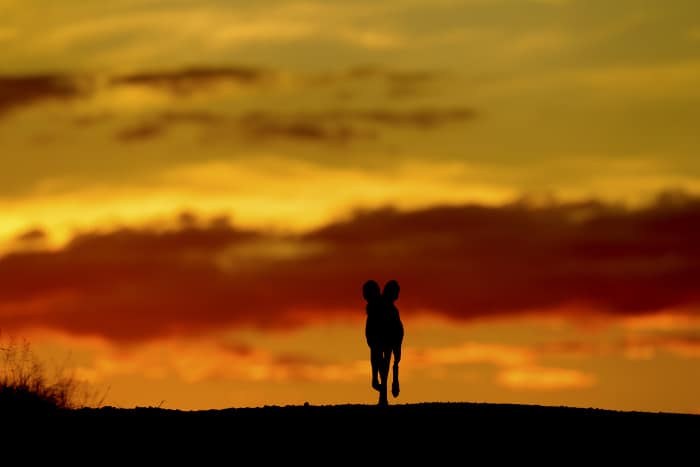
Why are the African wild dogs endangered? Before we dive into the reasons for the population’s decline, let’s look at some of the facts.
This includes the African wild dog conservation status, distribution, and population.
African wild dog endangered status
Given the African wild dogs’ population decline, the animal is critically endangered on the IUCN Red List.
African wild dog distribution
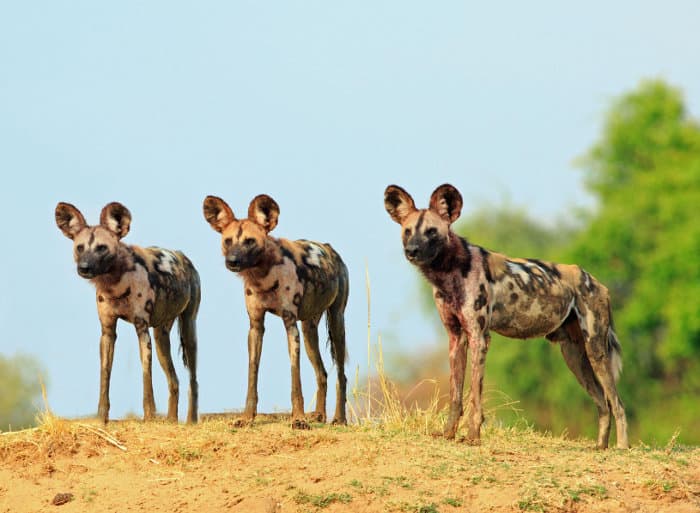
It’s believed that wild dogs once roamed across all of Africa. They are adept and adaptable hunters, able to find food in almost all of Africa’s habitats, from savannah to mountains to plains and forest.
However, they are now extinct from North Africa and have disappeared from 25 of the 39 African countries where they previously lived.
Wild dogs have enormous home ranges.
Research shows their numbers are highest in areas with incredibly low (or non-existent) human populations, plus a relatively low density of lions and hyenas.
They now only survive in a handful of places across sub-Saharan Africa. Their greatest stronghold is the wilderness area around northern Botswana and Zambia, where packs of up to 40 individuals can be seen.
African wild dog population
Wondering “how many African wild dogs are left”? It’s believed that the total wild dog population is between 3000 and 5000 individuals – that’s roughly 600 to 1000 packs.
However, exact figures are not known because their population is severely fragmented. What is known is that the African wild dog is the second most endangered carnivore on the planet (after the Egyptian wolf).
Unfortunately, figures are unable to show whether the wild dog population is increasing or decreasing. Experts in Africa’s safari industry believe the numbers are declining as wild dogs are seen far less than 20 years ago.
Why Are Wild Dogs Endangered? – The Causes
Wondering, “how are African wild dogs endangered?”
The African wild dog is critically endangered due to a variety of factors, notably severe habitat loss and habitat fragmentation, snaring, conflict with humans, and conflict with other predators.
African wild dog threats – other predators
All Africa’s predators are in competition with each other. This includes leopards, lions, wild dogs, hyenas, and cheetahs. When there is less food available, only the fittest will survive.
So, do African wild dogs have predators? Lion prides will kill wild dogs, especially the pups, in order to reduce competition for their own food source.
Additionally, brown, spotted, and striped hyenas successfully scare smaller wild dog packs off a kill.
While they may be Africa’s most successful hunters, wild dogs can’t compete with the strength and size of the big cats, including the lion.
Competition is a fact of life for all predators. For wild dogs, this carnivore competition must be understood in combination with other factors.
Lions and other predators drive wild dogs to the outer reaches of protected areas.
Here they are more likely to come in conflict with human populations and livestock.
As habitat for Africa’s wildlife declines, it’s those animals on the fringes that are most affected.
Research shows that African wild dogs spend most of their time in areas free of lions, locating their dens in areas with the lowest lion density.
This is very understandable – lions kill the canines and dominate the food source – but require a habitat large enough for multiple carnivore species.
African wild dog habitat loss
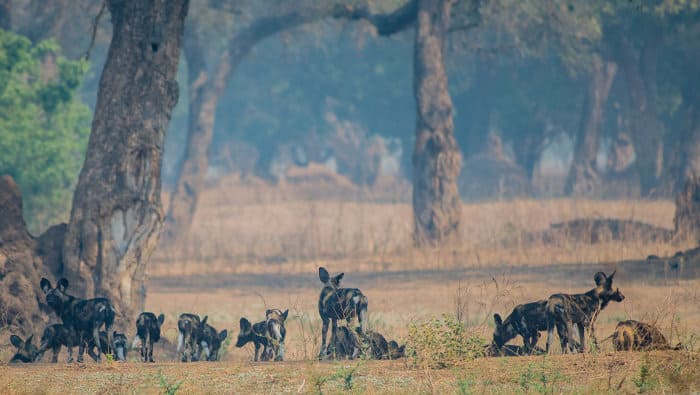
These social pack-living animals roam large territories and are continually in competition with other predators. They need space in order to thrive. Such space is becoming harder and harder to find.
Wild dogs need large protected areas. Before colonists arrived in Africa, they roamed freely across over 80% of the continent.
These endangered dogs are mostly nomadic creatures and cover great distances to find their food.
This way of living and hunting requires space, meaning wild dog populations can now only thrive in the larger wildernesses and parks.
An important population lives in Kruger National Park, a park that covers almost 20,000 square kilometers. 400-500 dogs can be found here, but you need at least a three-night safari to have a chance of encountering them.
In other parts of Africa, habitat loss means less space and food for predators. Wild dogs are pushed to the margins and eventually are unable to sustain themselves.
African wild dog habitat fragmentation
Like many of Africa’s endangered species, habitat loss appears to be irreversible. Roads and human settlements slice through natural migratory routes.
A rapid increase in population has meant more land is needed for both living and farming. There isn’t enough space for everything.
Habitat fragmentation is when a large continuous habitat is broken into smaller patches due to habitat loss. For example, building a road through a national park requires only a tiny percentage of the land.
But it fragments the habitat and prevents wildlife from moving freely. This is devastating for wild dogs as they need to move across large areas.
It’s no surprise that the largest wild dog population can be found in northern Botswana and Zambia.
This area is part of what will soon be known as the Kavango-Zambezi (Kaza) Transfrontier Conservation Area, the largest conservation area on the planet.
When fully created, it will cover five countries and be a similar size to Italy.
Kavango-Zambezi is a success story. Fragmented habitats are being pieced back together through international cooperation.
In most of the rest of Africa, the fragments are growing smaller and more numerous. This has a devastating impact on animals with a large natural range, among them wild dogs and elephants.
Conflict with humans

Over the last century, most habitat loss has been caused by farming.
Fertile areas are turned to farmland – some will say that is a necessity given Africa’s growing population.
It’s bad news for wild dogs because it’s their territory, on the fringes, that becomes farmland.
When wild dogs get too close to livestock, they are shot or poisoned by farmers. This is a story that’s rumbled on with different animals for the last 200 years.
Hippos and rhinos were shot abundantly because they grazed on crops. Virtually any wild animal coming into contact with a farm is considered a threat to profits, so whether baboons or wild dogs, they usually take a bullet.
Illegal (and legal) snaring
Despite their beautiful coats, wild dogs are not usually in the sight of hunters or poachers. Hunters are usually setting snares to catch antelope, in many cases for bushmeat but also for trophies.
Wild dogs hunt antelope. And they get caught in the snares left by hunters. This is terrible for any animal but especially so for the canine hunters.
Packs don’t leave anyone behind. They go searching for the missing individual and get themselves caught in snares as well.
Hunters typically lay several snares in the same area. So an entire pack of wild dogs can be lost due to this.
Diseases
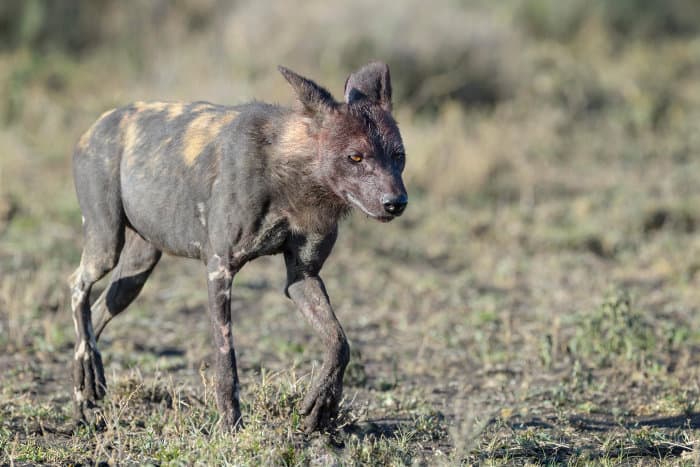
Another byproduct of the human-carnivore conflict is disease. Again, by traveling such large distances, wild dogs have a greater chance of coming into contact with diseases such as rabies.
Research shows that larger wild dog populations have a chance of recovering from outbreaks of disease, as they have a greater habitat they can move to.
However, small populations, where there are just a handful of packs, have been lost to epidemic disease.
When only one or two packs remain in a certain place, it doesn’t take much for them to be wiped out.
African Wild Dog Facts – Reasons to Save Them
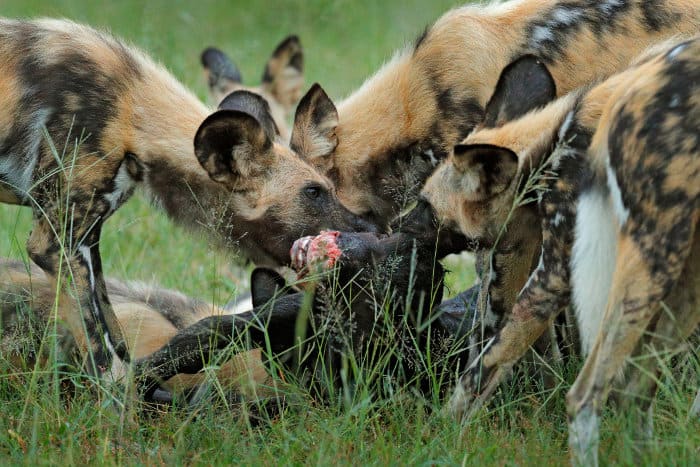
There are many reasons for saving the African wild dog from extinction. Let’s take a look at some of these below.
African wild dog hunting
Although they can look cute, these are vicious animals. They can mix it with the big cats and hold their own on the savannah. In fact, wild dogs have the highest hunting success rate of all the big predators (85% successful kills).
It’s all down to their incredible teamwork, allowing them to kill big wildebeest and even zebra. They typically hunt antelopes that range from 15 to 150 kg, with kudu, bushbuck, impala, and Thomson’s gazelle considered their favorite meals.
Hunting depends on sight, usually in the early morning or early evening, but also when the plains are illuminated by a bright moon.
Africa’s best teamwork

The pack hunts as a disciplined, single unit. It’s a fearsome sight to witness, perhaps the greatest of all encounters you could have on an African safari. What makes them so special is that the prey knows they are coming.
Big cats must creep up stealthily until they are in short striking range. However, antelope see wild dog packs from a kilometer away.
They hear them from four kilometers away. The pack howls loudly during a pre-hunt ritual, individuals greeting each other in an elaborate ceremony of noise and tail wagging.
Silently they depart. The pack fans out, roaming the savannah for antelope. When a herd has been identified, the leader will select a target through a series of signs and calls. Ideally, they target a young female and look to isolate it from the herd.
A subordinate male separates the target then the pack leader runs down the prey.
The others spread out and position themselves to make an interception if the antelope changes direction.
One or two dogs will lag behind, so they can grab the prey if it circles around and dodges the leader.
Africa’s best athlete
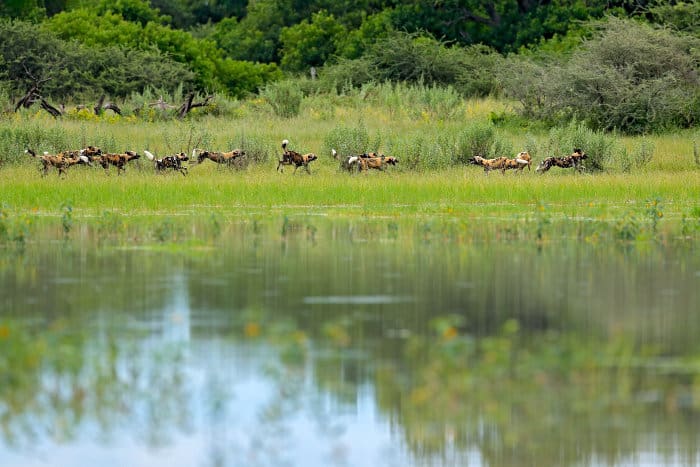
Cheetahs and lions can run faster. Other African mammals can travel further. But the wild dog is the ultimate athlete, a bit like a decathlete at the Olympics. They just keep running and running!
It’s a misconception that wild dogs run in relays to chase their prey. The pack leader can overtake their target after three to four kilometers, or at least within 30 minutes of starting the chase.
The top speed is 60 km/h, thanks to their long thin legs and lightweight frames. However, they know that a hunt is more a marathon than a sprint.
So even when the pack leader gets close enough to strike, they will hold back, forcing their quarry to exert more and more energy.
Wild dogs can maintain a speed of 40 km/h for five kilometers. That’s faster than Usain Bolt does the 100-meter sprint, kept up for 50 times the distance.
They literally run their target to exhaustion. Nipping and tearing at the fleeing victim helps to exhaust it further.
Then the rest of the pack hones in and bites away muscle from the rear of the animal.
And soon, the prey collapses dead.
Africa’s nicest social animal
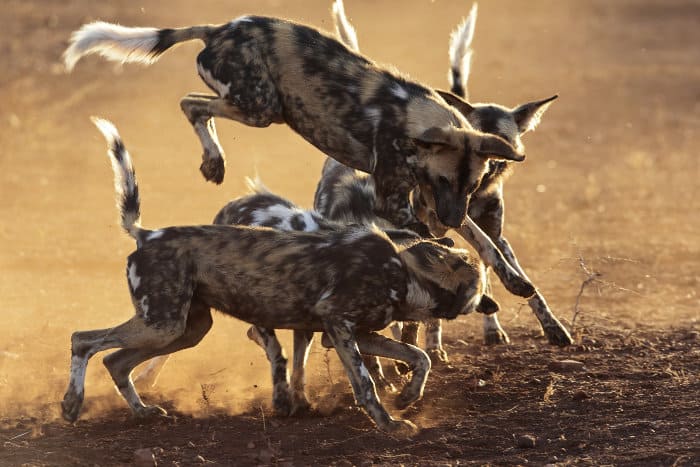
Lions are brutal.
Sick lions are left behind when a pride moves on.
When a kill is made, the big male dines first, followed by the females, then the other males get the scraps.
The dominant male lion will often kill and force out younger males in order to protect his own dominance.
But after wild dogs make a kill, the pack’s juveniles are allowed to eat first.
In comparison to chaotic and rowdy hyenas, wild dogs eat as if at a dinner table.
Each waits its turn, and if there isn’t enough food for the entire pack, they go out hunting again.
A litter of pups can be 8-12, although only half will survive their first year. That’s a lot of work for the mother, but she gets a lot of help. Babysitters are on hand, and the pack rather than the mother raises the pups.

And amazingly, pack members take care of the old and the sick, right up until the day they die! Subordinate females nurse any dog who isn’t strong enough to leave the den, including regurgitating food for them.
Unfortunately, this social style comes into conflict with the hyena.
Wild dogs are highly susceptible to kleptoparasitism, the practice of stealing prey from another animal.
The canines won’t risk taking food back to the den as it puts their young at risk from predators.
So their dining table is often interrupted.
Interbreeding, not in-breeding
These endangered animals are smart and don’t reproduce within the pack or with close relatives.
Instead, young same-sex groups leave the pack to join with small groups of the opposite sex, thus forming a new pack.
Interestingly, wild dogs will emigrate far away if they come back into the presence of their opposite-sex parent.
Wild dogs regulate antelope numbers and increase biodiversity
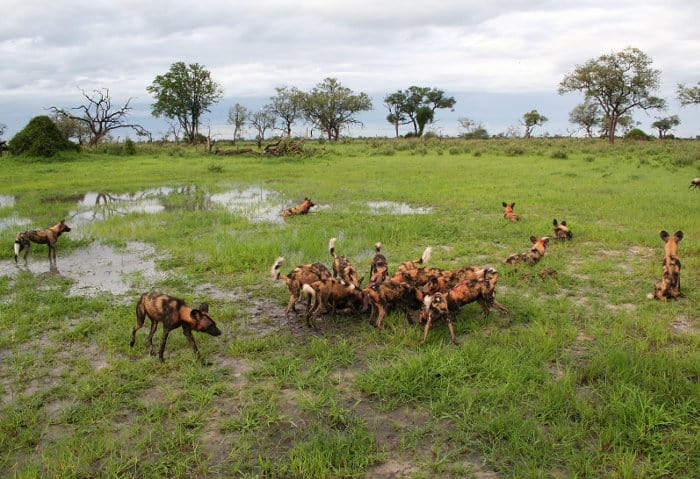
Wild dogs have a varied diet and can hunt a rich diversity of antelope. Studies have shown that packs will hunt abundant species, therefore helping to preserve the biodiversity of a landscape.
For example, in Kruger they mostly hunt impala. By helping keep the impala population down, more antelope species can share Kruger’s food sources.
So not only are wild dogs hunting to feed themselves, they are regulating a landscape’s mammal diversity.
How to Prevent African Wild Dog Extinction?
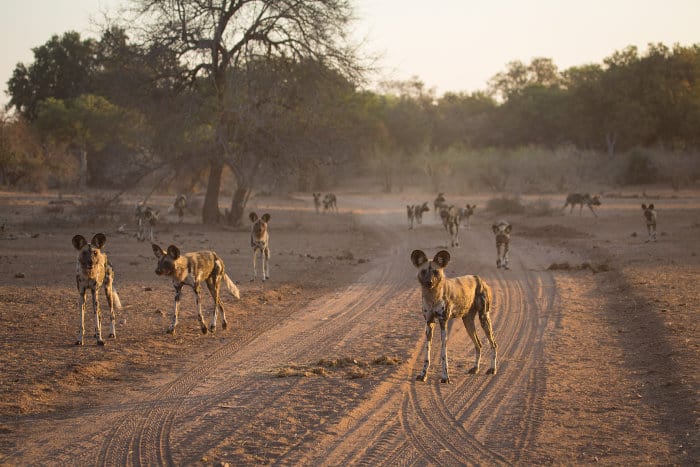
So you may be wondering how to save African wild dogs. Stopping habitat fragmentation and reconnecting fragmented habitats is the best way to increase the African wild dog population.
The best thing you can do is to take action. How do you do that? Connect with your wild side and go on an African safari!
By going on safari, you can experience the plight of different species, informing yourself of what is happening on the ground. You’ll become a defender of wildlife and later speak up for wildlife.
African safaris also provide much-needed funds for conservation.
Every piece of land must pay its way, and without park fees, there would be no national parks and no wildlife.
Safaris ultimately financially support local communities, so they don’t need to harvest wilderness areas to plant cash crops.
Where to See the Endangered African Wild Dog?

Not in a zoo, that’s for sure! African wild dogs are truly wild and are best seen on a safari.
I’d recommend a safari in northern Botswana, around Moremi Game Reserve in the Okavango, Linyanti Private Concession, and Chobe National Park. After the safari, you can hop over the border to Victoria Falls.
South Luangwa National Park in Zambia is another excellent place to see wild dogs in the wild.
For a chance of spotting African wild dogs, book an African safari today.
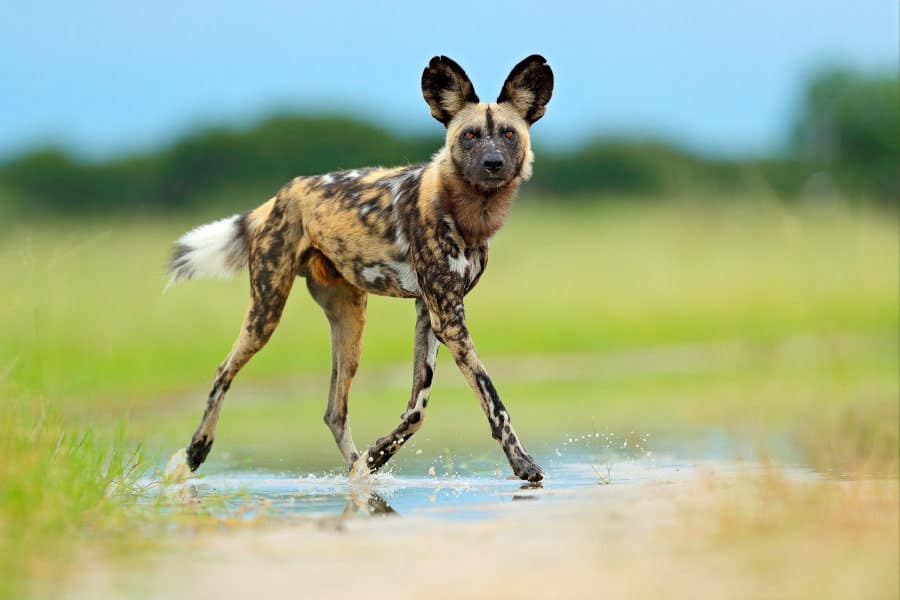
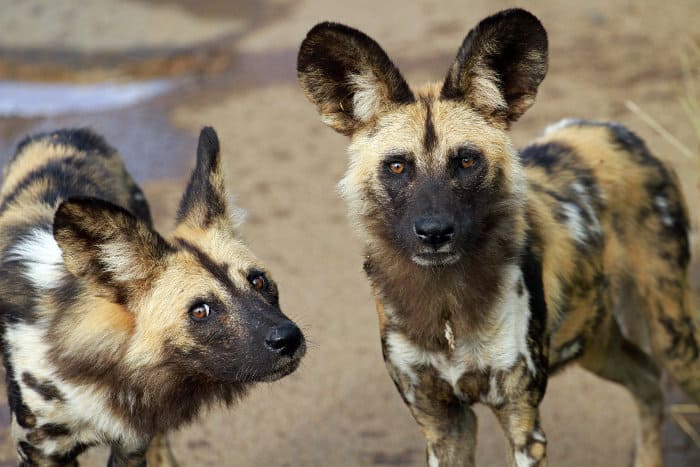
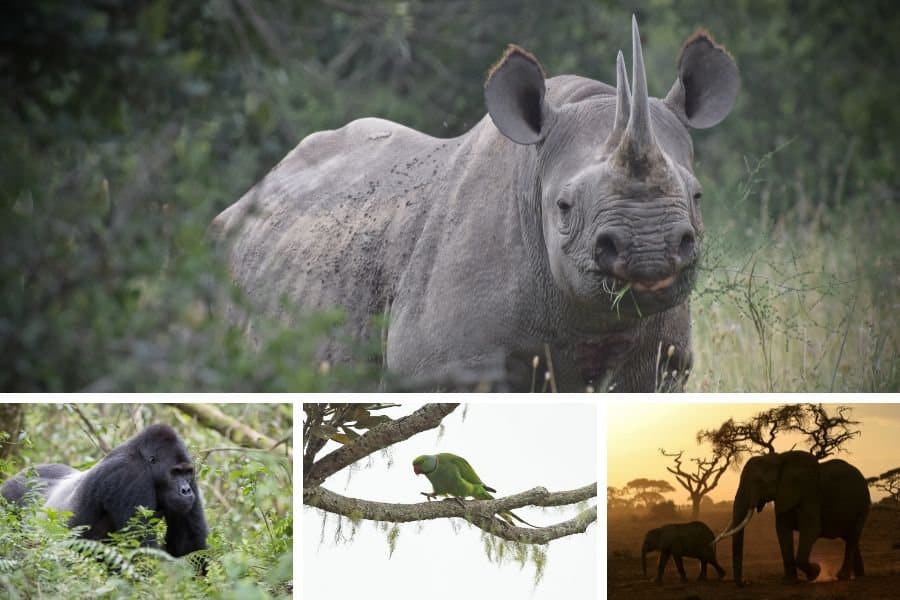

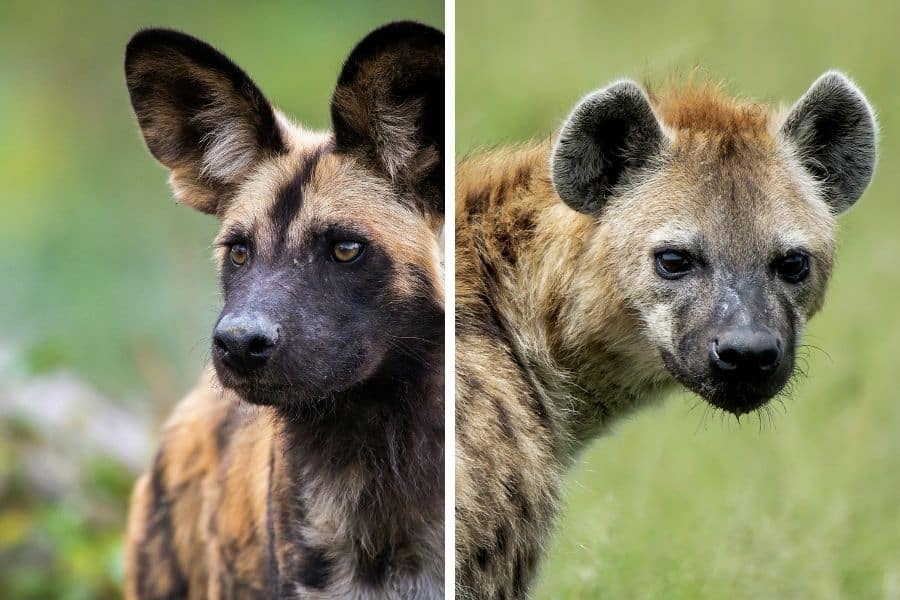
Very good story. Thanks for that.
We have been living in South Africa for many years and we have got the chance to visit Kruger National park at least once every month.
We did see wild dogs relatively often. They were playing in front of our car. Bathing themselves in the urine of elephants and other elements to not have their own smell when approaching their prey.
We were also very lucky to see a group of pups guarded by an adult.
Hopefully their groups can expand so that these lovely animals will not disappear in photobooks only.
Thanks for sharing your wild dog experiences, Ad. It’s great to hear these wonderful animals are still being spotted somewhat regularly.
South Africa is indeed a good country to encounter wild dogs in their natural habitat.
All the best,
Michael
Since the number of lions lessens in East Africa you can find wild dogs again, for example in Kenya.
Only a few years ago we met a pack of about 30 in Tsavo West near Ngulia Range.
Lucky you, a pack of 30 individuals is relatively rare.
I haven’t been that lucky (yet). Last time I had a chance to seeing them was in the Selous Game Reserve, Tanzania. But they had left the scene only minutes before we got there.
What you say about lions is very interesting. Are you familiar with any study that supports your observations?
Indeed, the plight of one species can be beneficial for another.
Very informative. Keep it up.
Glad you enjoyed it, David. 🙂
If you have topic suggestions or anything else you’d like to add, feel free to do it.
We constantly strive to improve.
Cheers!
Michael